Request for Consent Review 2017 – Whangamata
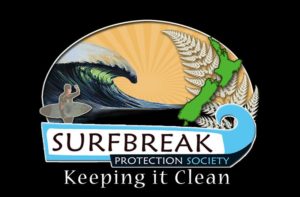
P.O Box 58846 Botany Auckland 2163
www.surfbreak.org.nz
info@surfbreak.org.nz
29 November 2017 BY EMAIL
| To: | Alan Livingston | Chair; Waikato Regional Council |
| Vaughan Payne | CEO; Waikato Regional Council | |
| cc: | Hon Eugenie Sage | Minister of Conservation |
| Hon David Parker | Minister for the Environment | |
| Hon Nanaia Mahuta | Minister of Local Government | |
| John Tregidga | Chair of the Hauraki Gulf Forum | |
| Tim Higham | CEO of Hauraki Gulf Forum | |
| Liane Ngamane | Member of the Hauraki Gulf Forum | |
| Pauline Clarkin | Ngati Hako | |
| Nathan Kennedy | Ngaati Whangaunga | |
| David Taipari | Ngati Maru | |
| Gary Taylor | Environmental Defence Society | |
| Madeleine Wright | Environmental Defence Society |
Request to Review WRC granted consents 121398, 121399 held by the Whangamata Marina Society Inc, and; consent 119263 held By Thames Coromandel District Council
Five years ago, on September 27th 2012 , The Hauraki Gulf Forum (HGF) Chair John Tregidga wrote to Waikato Regional Council (WRC) CEO Bob Laing referring to the WRC decision to review conditions of maintenance dredging consents (121398 and 121399) held by the Whangamata Marina Society at the confluence of the Moana anuanu delta, and had received an offer from the Environmental Defence Society (EDS) to hold a workshop to reach a common understanding on the physical processes that are occurring at Whangamata Bar surf break.
EDS also provided SPS with a memo outlining the legal options available to the Surfbreak Protection Society (SPS) should WRC decline to initiate a consent review (see attached Appendix 1).
In his letter John Trediga also stated that: “I welcome both of these developments and ask that you keep me appraised on progress in these matters.”
This occurred because of the presentation of our report to the Hauraki Gulf Forum titled:
The Whangamata Bar Dredging of the Moana anuanu Stream and Observed Adverse Effects on the Whangamata Ebb Tidal Delta (See attached Appendix 2).
WRC Bob Laing replied: “The aim of the review is to establish whether the marina dredging activities are the driving forces for the changes at the Whangamata surf break.”
SPS were briefly informed by WRC that a review was taking place, and whether we had any further science to add. SPS informed WRC of the type of science that was required, but received no further information in regard to the progress the consent review.
The consent review evaluation memo in 2013 by WRC coastal scientist Vernon Pickett strongly recommended the same type of science to ascertain any adverse effects from the dredging on the Whangamata Bar surf break, in the five years since the consent review, this has not been undertaken.
During the review period between December 2012 and May 2013 the terms of reference of the consent review under section 128 of the RMA were trimmed as follows, without consulting the HGF,EDS, or SPS:
Condition 23 of resource consent 121398 and condition 26 of resource consent 121399under section 128(1) of the RMA :
- to review the effectiveness of the conditions of this resource consent in avoiding or mitigating any adverse effects on the environment from the exercise of this resource consent and if necessary to avoid, remedy or mitigate such effects by way of further or amended conditions; or
- if necessary and appropriate, to require the holder of this resource consent to adopt the best practicable option to remove or reduce adverse effects on the surrounding environment; or
- to review the adequacy of and the necessity for monitoring undertaken by
the consent holder.”
SPS has historically protested the adequacy of the type of monitoring undertaken to fulfil the Environment Ministers strict condition for monitoring the Whangamata Bar by the marina society, and subsequently accepted by WRC.In 2006 after a deferral from the then Conservation Minister The Rt Hon Chris Carter,The then Environment Minister The Rt Hon David Benson Pope granted the marina consents with a strict condition regarding the monitoring of the Whangamata Bar[1]:
| 10. | The consent holder shall retain appropriately qualified and experienced persons to develop a plan detailing procedures to be put in place to minimise the potential for sediment discharge from the site during construction of the works. This plan shall address among other things the following:…. |
| vii. | monitoring of the sand bar at the harbour entrance to ascertain if the dredging and construction has any long term adverse effect |
[1] The Rt Hon David Benson – Pope letter to the Surfbreak Protection Society; http://www.surfbreak.org.nz/wp-content/uploads/2012/06/Appendix-3-Whanga-Bar-report-letter-to_Minister_and_conditions.pdf
In a letter to SPS after The Rt Hon David Benson – Pope released his decision, he explained his reasoning behind the decision: I specifically asked the Environment Court about the surfing issue…. and; …If erosion of the sandbar does become a problem in the future, it will be addressed in the circumstances of the time.
During the consent review without informing the other parties involved, WRC adapted a legal opinion from another consent review requested by the Friends of Lake Taupo to conclude that:
“I do not consider that further research to better understand the estuary system should form part of the review…the review is not an opportunity to re-litigate the original grant of consent or the decision makers findings or evidence before them.”
Consequently, the decision by WRC on the narrow review clause and the legal opinion, resulted in stating there is no further monitoring required by the consent holders.
Certainly that decision was not supported by SPS, mainly due to the haphazard manner that the monitoring process took place over that period of time. SPS maintains that you cannot get good results if you are not monitoring for the right parameters. If you fail to measure correctly, you will fail to get the correct result. Hence our reason for a revisit and review.
At the beginning of the Consent review WMS applied for, and received a non notified consent 125909 for dredging using the Lift & Drift method, to which SPS had lodged its original compliant sparking the consent 121398 review.
Surfers noted to the Environment Court hearings for the marina that we were concerned as to the effects of the Whangamata estuary inlet throat opening up, and to the potential adverse effects on the Whangamata Bar due to maintenance dredging activities.
The Environment Court was satisfied that the current dredging volumes of 2,000 to 3,000m3 per annum already undertaken by TCDC at the time would only be undertaken at 3,000m3 and expectedly less than 6,000m3 per annum. Without any public consultation, this morphed into 10,000m3 per annum, even though consultation was requested by SPS.
Consent 125909 granted December 3rd 2012 for the Lift and Drift method provides no conditions for monitoring the Whangamata Bar surfbreak, although the comments of the non-notified consent recognises that: The proposal has the potential to alter coastal processes within the sediment system and potentially affect the ebb tidal delta which is recognised as a surf break of national significance in the NZCPS.
Since the consent review ended in May 2013 after six months of no maintenance dredging at Whangamata, SPS initiated our own photographic evidence of changes to the inlet throat, and immediately noticed changes to the width of the Tidal Inlet Gorge within days of the dredging commencing.
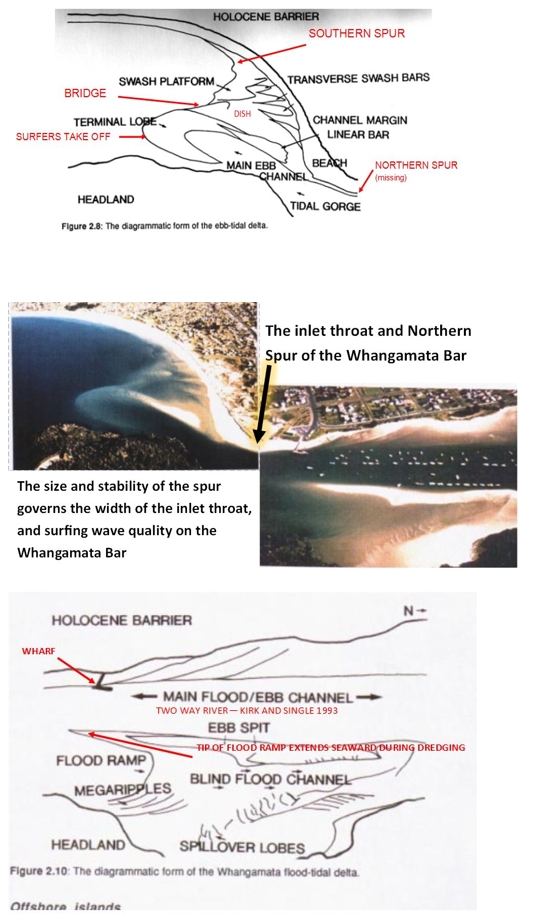
The photo below illustrates the modified Te Wairoa Stream, confluence, and main channel of the Whangamata estuary
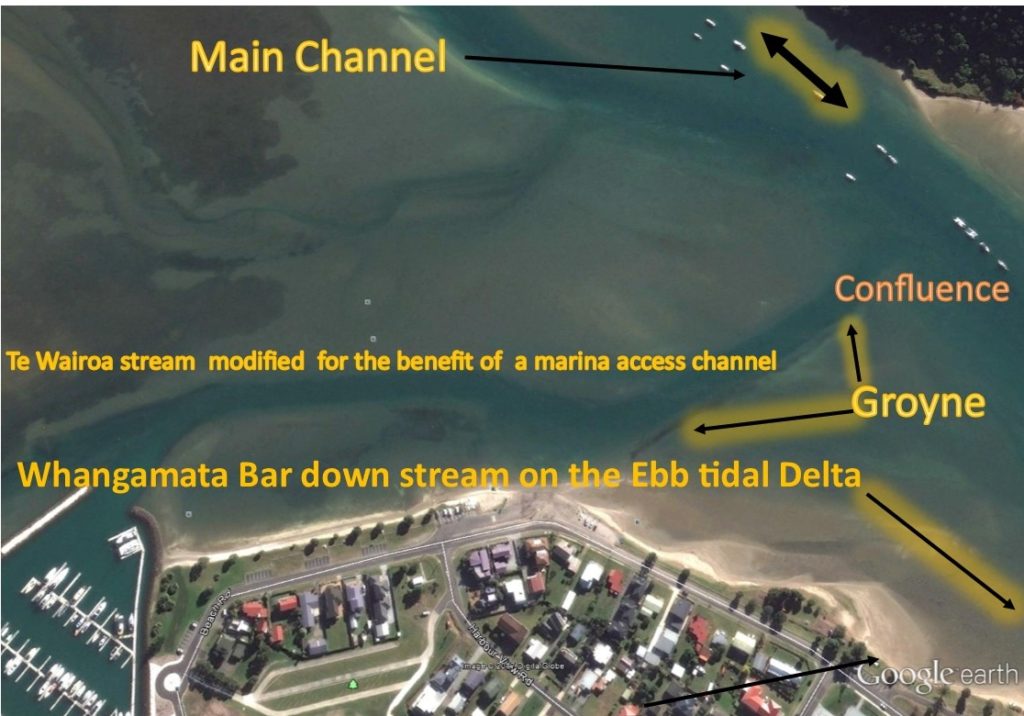
What is referred to as the spur, the Northern base of the Whangamata Bar, photo taken on the 14th May 2013. Dredging commenced under the new consent 125909 after no dredging at all for six months (note the pole in the centre of the photo as a reference point).
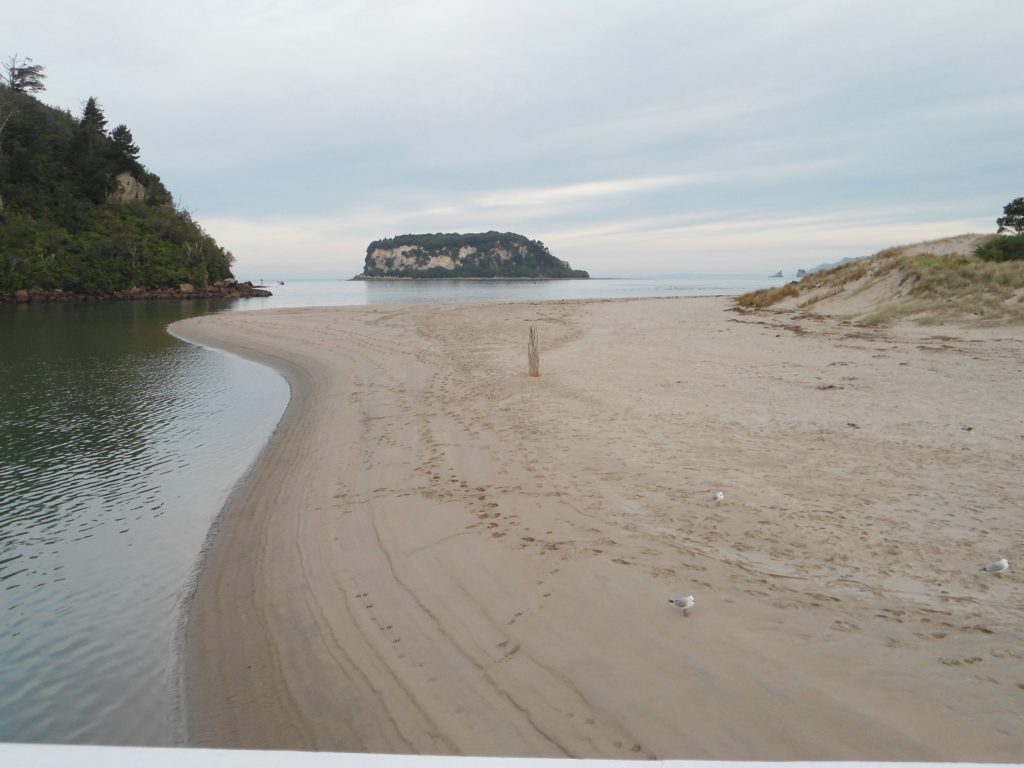
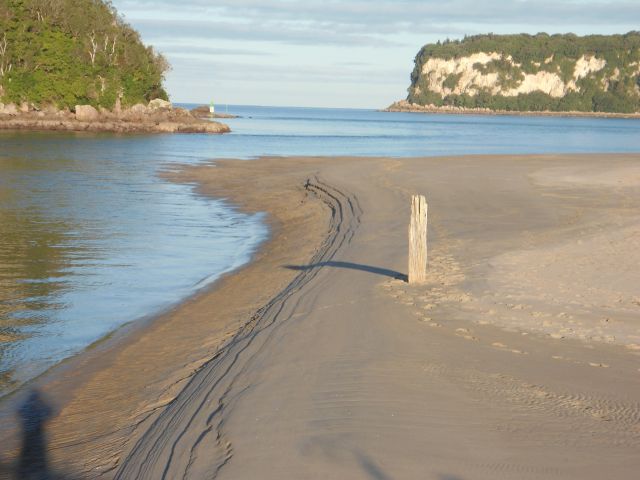
Photo taken 30th June 2013 the spur of the Whangamata Bar erodes within days and/or weeks of the dredging, diminishing surfing wave quality at the Whangamata Bar.
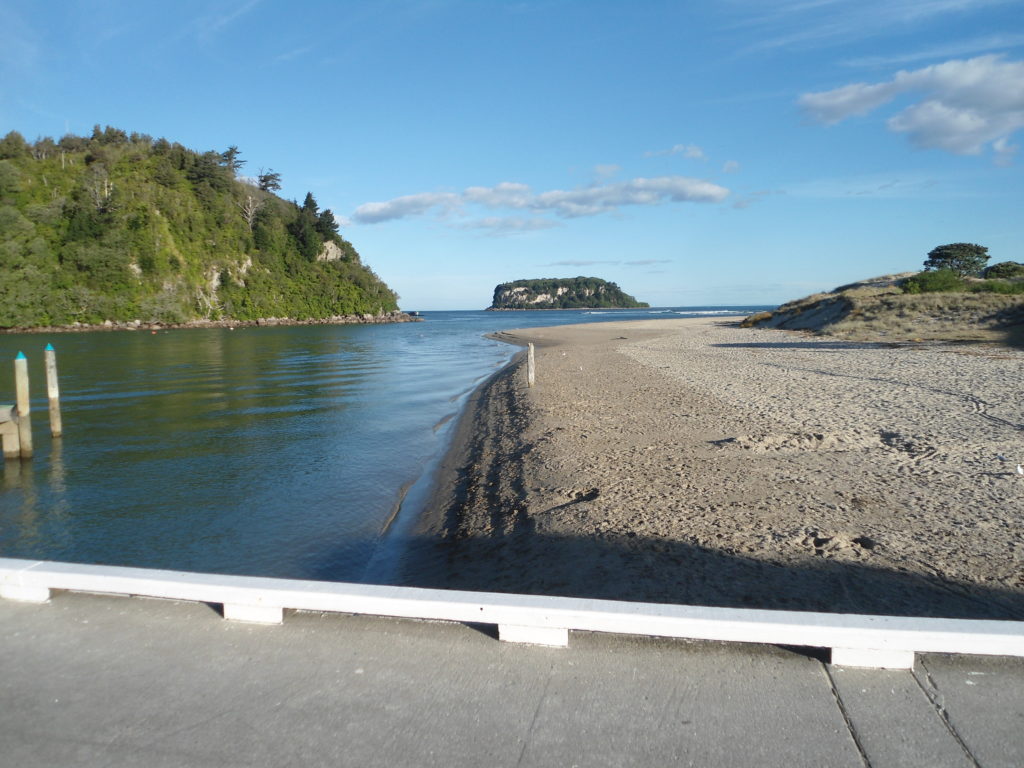
March 2014 after consecutive near monthly maintenance dredging, the inlet throat wide open, the Bar never again achieving the 10 out of 10 surfing wave quality that it is world famous for.
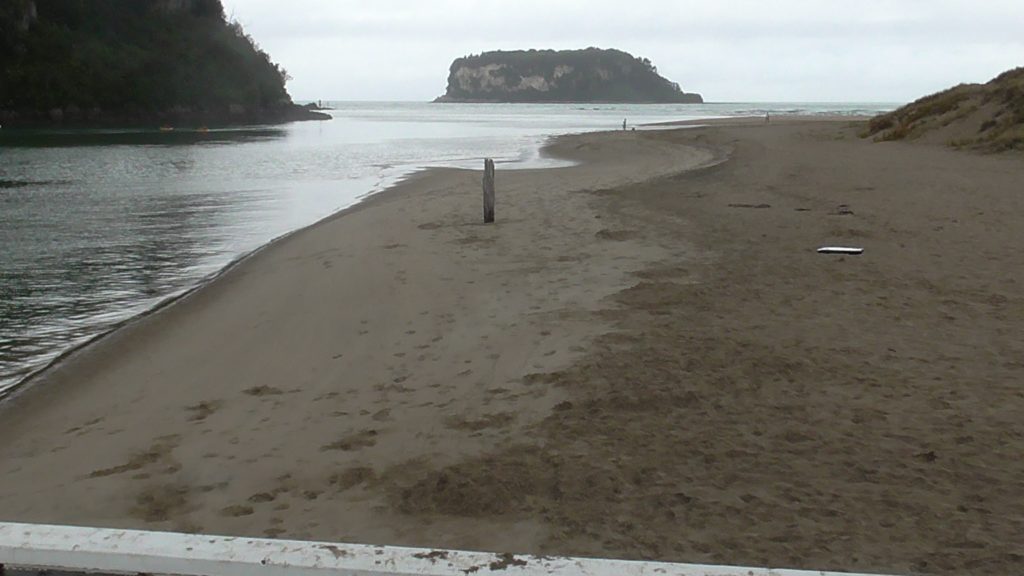
18 of January 2016 after large dredging in December 2015 throat widens even further..
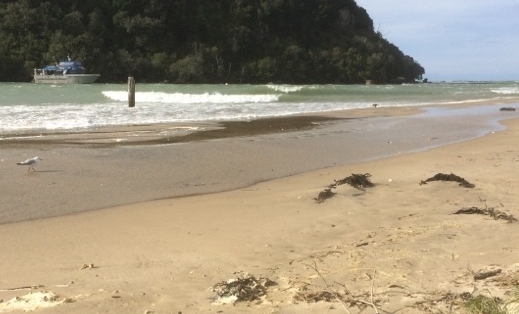
11 of July 2016 and the spur well rounded off and waves breaking into the harbour, never seen previously. The Throat of the inlet forced open allowing large volumes of sediment to travel up into the estuary, with degraded surfing conditions on the Whangamata Bar maintained by the dredging regime.
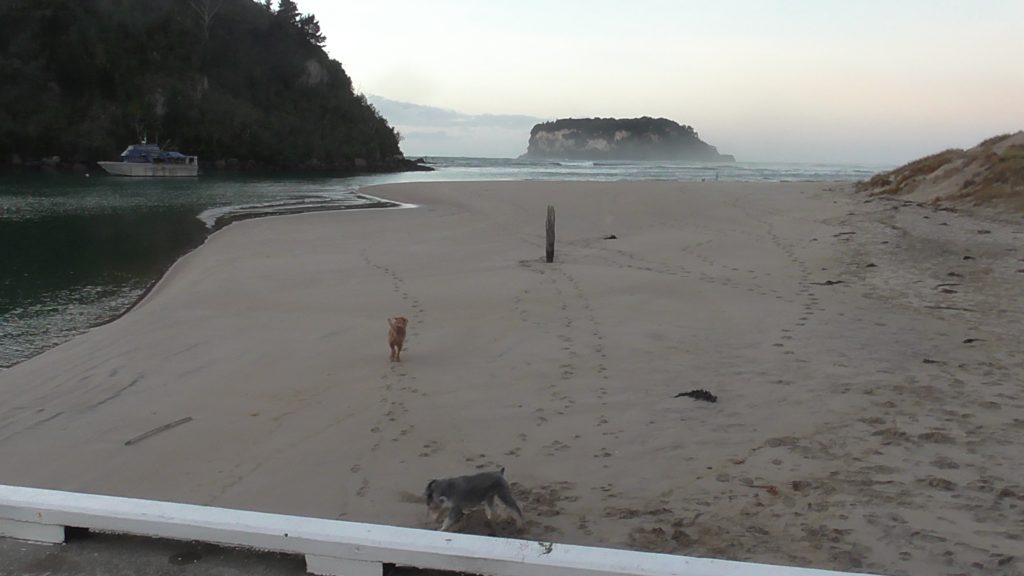
13th of July 2016 Spur rebuilding due to heavy storm swell, the more sand on the spur, the more the estuary is protected from infilling of ocean sand.
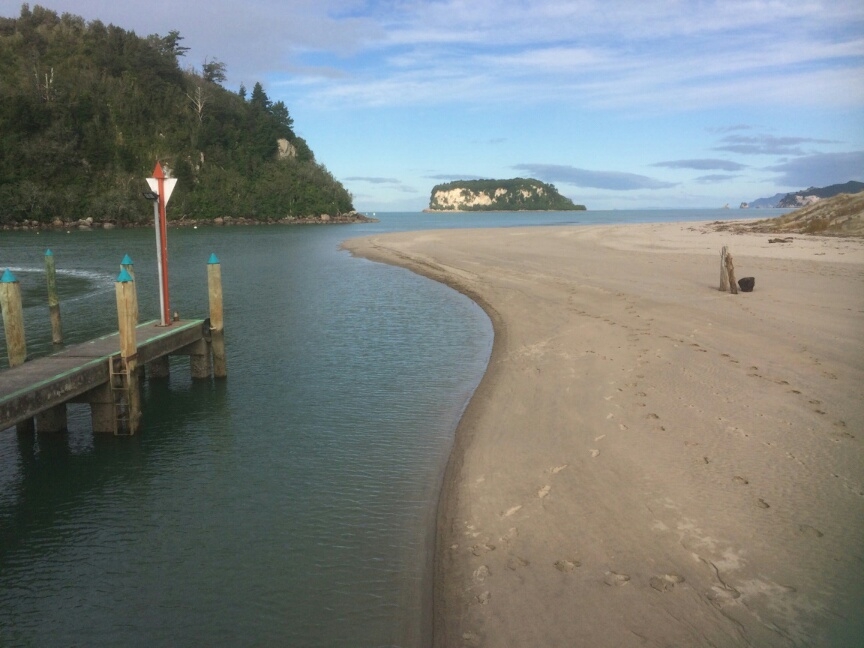
24 July 2017 the spur rebuilding after a swell event…taken just before dredging that same day, good waves on the 20- 23rd. Swell has increased the spur, and coinciding with improving surfing wave quality on the Bar.
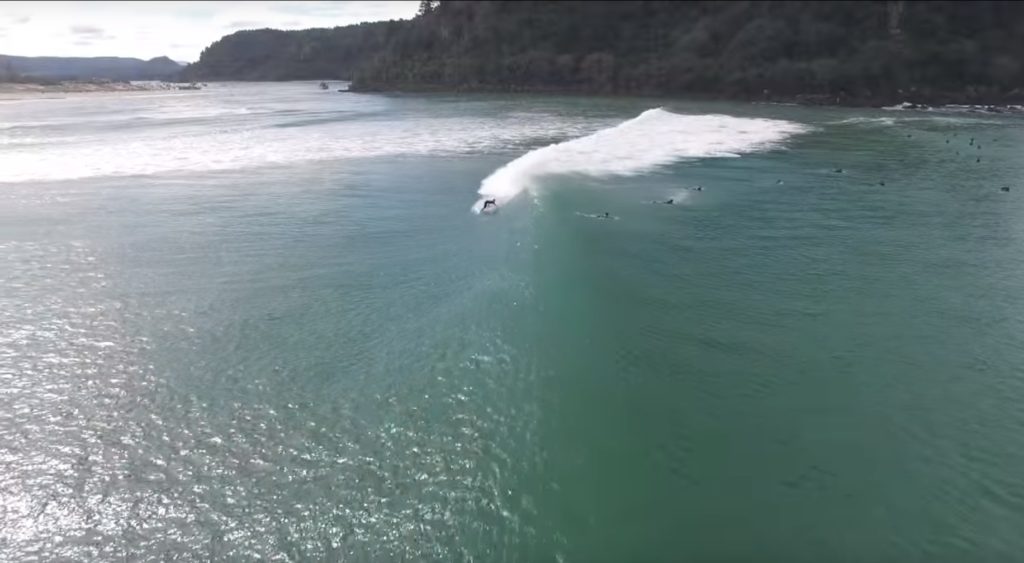
Photo of surfer riding the Whangamata Bar looking into the estuary
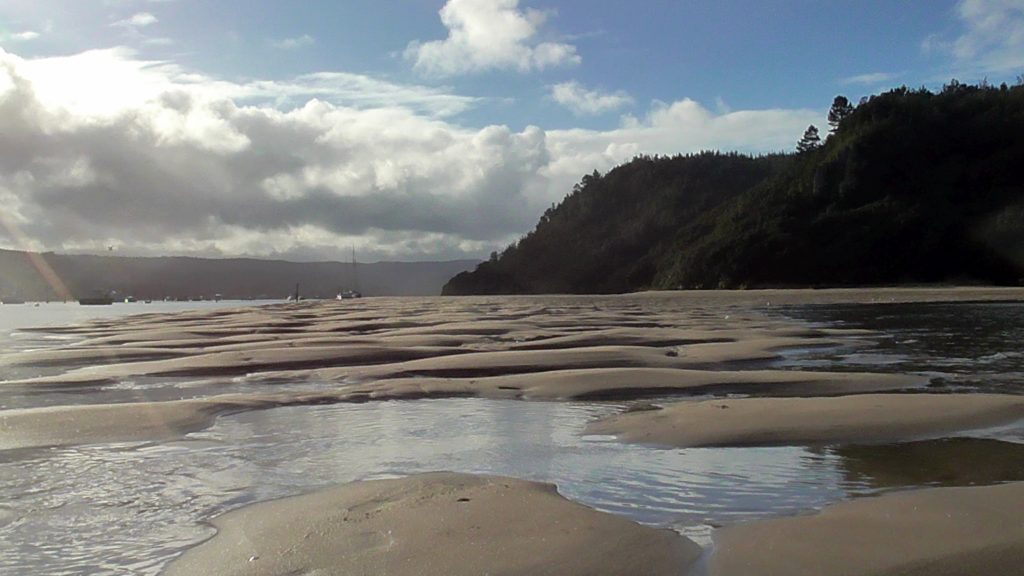
The Flood Tide delta, due to accretion mega ripples directly after a dredging event,

Mega ripples due to erosion from the base of the Whangamata Bar up toward the wharf after dredging
SPS has collated 5 years of photo and video evidence since 2013 of the changes to the inlet throat, which opens up a channel through the middle of the Whangamata Bar and consequently cutting up the world renowned surf break. WRC coastal scientist Vernon Pickett commented there was a difference in pre and post marina wave quality on the Whangamata Bar and strongly recommended continued monitoring of the Whangamata Bar which ceased with the granting of consent number 125909.
The Hauraki Gulf Forum Governing the Gulf Guidelines 2009 to which WRC is a signatory: “Giving effect to the Hauraki Gulf Marine Park Act through Policies and Plans.” Page 79, Policy and Planning section (F).3 states:
Identification of natural and physical resources of recreational importance and methods to protect them, including:
surf breaks by restricting activities such as dredging which – have the potential to modify seabed contours and sediment dynamics,
The Whangamata Bar was a key issue throughout the environment court process and SPS engaged both WRC and WMS as soon as the consents were granted to discuss the best methods to employ in order to avoid adverse effects on the Whangamata surf break.
Our advice was ignored, and consents were granted non notified by WRC in September 2010 for maintenance dredging for the volume of 10,000m3 over three times that discussed at the court.
What SPS has observed is a cascading effect (the horizontal avalanche), where within days or sometimes hours the flood tidal delta increases in height, length and volume, which increases the current velocity compressing against the in-filled moorings on the south side of the main channel.
The result is that the current direction is changed to the southeast, this then erodes the northern spur of the Whangamata ebb tidal delta at the estuary entrance, which in that process becomes saturated, / liquefied, sediment is then transported out into the bay on the outgoing tide and up the estuary on the incoming tide (the reason for dredging). The terminal lobe of the Whangamata Bar is also mobilised along with the spur material. The terminal lobe is distorted and establishes itself further out to sea and to the south-east as the existing Te Karaka channel between the 2 green markers silts up, assisting the migration of both channel and terminal lobe.
The inner Bar tidal jet then changes to directed sediment to the decreasing northern spur. If there is no swell and a number of dredging events, the bridge of sand known as” the Bridge” or mid-section collapses into where the Dish in the Bar has deepened ( naturally 0.5m.- increases to 2m. coincidently the same dredged depth of the Te Wairoa/Moana anuanu delta).
Sediment of the southern spur of the Bar is then on the move by way of, wind, tide, and swell- wave driven current which then transports the sand north along the beach drawing sand from as far back as the surf club, and also from the “Hume slug” of sand deposited (from the dredging activities) in the centre of the Bay[2] which in turn in-fills the swash bars and the Dish, this process along with swell from the northeast swinging through to the south-east,rounds the terminal lobe carrying sediment down the bar which repairs the bridge. From that the estuary entrance narrows as the northern spur is re-established…
[2] Identified by Dr. Terry Hume at MBIE study meeting Waikato University 5 Feb 2017
The ebb tidal delta begins to restore its equilibrium as soon as the dredging effects are reduced, this positive effect is amplified if strong swells are occurring. The north spur and the terminal lobe move back to the north and the Te karaka channel re-establishes itself parallel to the cliff for longer rides and improved vortex / velocity by which time the dredged Moanuanuanu channel has in-filled, then it is deemed by the Marina Co. that a new dredging activity needs to commence, repeating the artificial monthly cycle of sediment, erosion accretion and transportation.
SPS informed WRC that the Whangamata Bar was one of 17 nationally listed surf breaks in schedule one of the New Zealand Coastal Policy Statement, later gazetted December 3rd 2010 and that there were legislative responsibilities to avoid or remedy any adverse effects.
The Whangamata Bar is a NZCPS listed surf break where all adverse effects must be avoided under policy 16 of the NZCPS, the Whangamata bar has the equivalent status as that of a National Park, Yet WRC are failing to give effect to their legislative responsibilities by not ensuring that the adverse effects from the dredging activities on the surf break are avoided.
WRC should ensure that a monitoring process as set out by the late WRC coastal scientist Vernon Pickett is implemented, particularly as the dredging consents are set in place for lengthy periods. The Whangamata Bar is unique and finite. It is crucial to the Whangamata and Regional economy that the surf break is not further comprised or destroyed.
SPS respectively request WRC to utilise the 5 yearly review clauses in the resource consents119263 and 121398 conditions below to revisit the issue of setting in place a robust system of periodic monitoring based on surf science that would give all parties security in the knowledge that a best practice solution is in place.
SPS hereby inform WRC that this letter has been sent on this date, the 29th of November 2017 within two months either side of September as per condition 23of consent number 121398.
A table of consents held for agencies responsible for maintenance dredging at Whangamata.
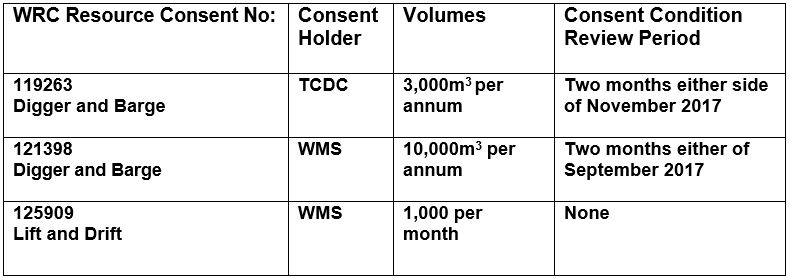
SPS look forward to the response from WRC in a timely manner on our request and are willing to enter into further communication or providing further information
Yours Sincerely
Paul Shanks
President
Surfbreak Protection Society
Attachments to this letter:
Appendix 1 – SPS letter to WRC with EDS memo outlining legal options
Appendix 2 – Our 2012 Whangamata Bar Report
Digger and Barge Consent no: 119263 and evaluation report (granted non notified March 2010)
Digger and Barge Consent no: 121398 (granted granted non notified Sep 2010)
Lift and Drift dredging consent no: 125909 (granted non notified December 2012)
Lift and Drift dredging consent no: 125909 Evaluation Report

